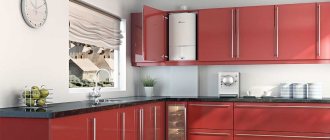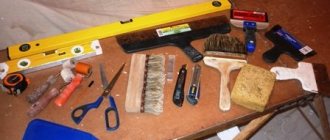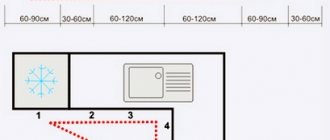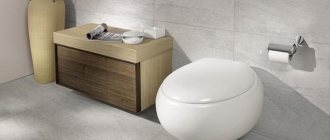Although a microwave in the kitchen does not take up very much space, unlike, for example, a refrigerator, finding a suitable place for it can be difficult. Perhaps there are no problems only with built-in equipment; it is initially purchased for a specific niche. Other types of microwaves are placed in the kitchen in different ways: on tables, in corners, on shelves, etc., except that they are not hung above a gas stove. This material discusses various options for placing microwave ovens, as well as the rules that it is advisable to adhere to when determining the place where the purchased equipment will be located.
Ideas for placing a microwave oven
The question of where to put a microwave in the kitchen so that it is convenient to use arises even if you have a spacious kitchen, not to mention small rooms. The point here is often not only in the available square meters. For example, the location of kitchen outlets already limits the way the microwave can be placed. The optimal location of the stove can compete with the TV - in general, there are not many places where this device can be placed. Nevertheless, there are enough ideas for placing such equipment, so you can almost always find an acceptable option. Let's look at these options in detail.
Spices that have been stored for a long time can be restored to their former aroma using a microwave oven. To do this, just warm them up in a closed bag for about fifteen seconds.
Placing freestanding microwaves
If a built-in model is available, then the question of how to place a microwave in the kitchen does not arise. In this case, there is a niche in the kitchen unit for the microwave, and the device is purchased specifically for this niche. However, the vast majority of home microwave ovens are free-standing units and there are many options for placement. The optimal location depends on specific conditions: the size of the kitchen, the dimensions of the oven itself, the location of kitchen outlets, etc. Below are options for freestanding microwave ovens that can be applied to almost any kitchen.
Kitchen countertop
The simplest and most common way to place a microwave oven in the kitchen is to install it on the kitchen countertop. This option has a number of advantages, namely:
- a stove placed in this way is at the optimal height for a person - there is no need to reach up or bend down to use this device;
- the countertop itself is a kitchen work area, so the stove installed there will be located not far from other kitchen equipment, various utensils, hoods, products, etc. — everything necessary, including the stove itself, will be at the user’s fingertips;
- In addition, the countertop is a flat, stable surface - this is exactly what is most suitable for a microwave.
Unfortunately, it is not always possible to install a microwave oven on the countertop. In small-sized kitchens, the size of the countertop itself is limited, and installing a microwave there significantly, and sometimes radically, reduces the available work surface. In addition, it is not advisable to place the stove next to a gas or electric stove, or next to a sink. So, when deciding where to put a microwave in a small kitchen, you often have to consider other options.
Windowsill
One of the options for solving the question of where to put a microwave in a small kitchen is to install it on a windowsill, if, of course, the size of this window sill allows. Wide window sills are similar to a kitchen countertop, but they are “recessed” into the wall, forming a kind of niche, similar to those in which kitchen equipment is built. The height at which the window sills are located usually approximately corresponds to the height of the kitchen worktop, i.e. is optimal for the user. The surface of the window sill itself is flat, and there are no problems with stability.
Despite all the listed advantages, the option of installing a microwave on a windowsill is not without significant drawbacks. Let's list them:
- The stove may be exposed to direct sunlight, and this is undesirable, because they can heat up the equipment greatly, which will eventually lead to damage to the device;
- a window can be a source of drafts, condensation and sudden temperature changes, which also negatively affects the performance and durability of the equipment;
- the microwave restricts access to the window; it cannot be opened without removing this device;
- If there are heating batteries under the windowsill, the equipment located on the windowsill will overheat during the heating season.
Fridge
If there is not enough space, you can, in principle, put a microwave on top of the refrigerator in a small kitchen, if, of course, the refrigerator has an acceptable height. This is far from the best option, but if there is an acute lack of space, it is also used. Among other things, the vibration of the refrigerator during operation is also a disadvantage; over time, this negatively affects the equipment located on it.
When using a refrigerator to place a microwave oven, it is recommended to install the oven not directly on the top of the refrigerator, but to use some kind of stand made of heat-insulating material. It is also a good idea for the stove to stand on small legs - this will improve its ventilation and reduce the flow of excess heat to the refrigerator.
If a microwave oven that failed before the expiration of the warranty was placed on a refrigerator during the period of operation, this may become grounds for refusal of warranty service.
Dishwasher
Often a situation arises when the purchased stove is difficult to attach anywhere, because... all convenient places are already filled with various kitchen equipment. Is it possible to install it on another device in this case? I guess, yes. One option is to install a microwave on the dishwasher. The surface of such a machine is smooth and stable. The machine itself does not overheat during operation. Nevertheless, it is advisable, as in the case of a refrigerator, to install the microwave oven not directly on top, but on a thermally insulated stand. Also, it is not recommended to turn on both of these devices at the same time.
Washing machine
If there is too little space in the kitchen unit to accommodate a microwave, you can also install it on the washing machine. This is far from the best option. On the one hand, a standard washing machine is suitable in height, and its surface area is quite enough to install a stove. On the other hand, you need to remember that the washing machine vibrates during operation, so it is advisable to provide some kind of microwave mat that prevents this device from slipping. You should not install an oven that is too heavy on the washing machine; it can simply deform the surface of the washing machine. It is recommended not to place models that weigh more than fifteen kilograms on washing machines.
Hanging open shelf
If there is not enough space for placing a microwave oven, you can adapt any open shelf. It is only necessary that it be securely attached to the wall, support the weight of the stove, and be installed at a height comfortable enough to use the microwave. Usually the shelf is located closer to the outlets and the kitchen work area, but in principle it can be placed anywhere - in a corner, in the middle of the wall, etc., except that they avoid placing a microwave above the stove.
You can build a shelf yourself, order its production, or use a purchased product. Shelves are usually made from suitable materials that are easy to clean from accumulated dirt. In addition, industrial kitchen shelves often have additional capabilities; for example, various kitchen utensils can be hung from below the shelf.
Shelf under wall cabinets
Actually, this is the same open shelf for a microwave oven, only installed under wall kitchen cabinets. The advantage of this location is that the microwave will be located directly in the kitchen work area, without taking up space on the countertop. So this is a good option, even if there is somewhere to put the microwave.
Niche in the kitchen cabinet
Kitchen sets often have niches that can be used to install household appliances, including microwave ovens. Typically, such niches are of an open type and do not have doors, which, in general, almost completely solves the problem of ventilation of household appliances during operation. Niches, as a rule, are located either directly in the kitchen work area or not far from it. Perhaps the main problem when using niches is connecting equipment to the electrical network.
bracket
Among the various ideas for placing microwave ovens, the most popular option is using a bracket. This option, in fact, is very close to using a regular shelf, but the bracket looks more stylish. The bracket does not have any advantages over the shelf. When deciding where to install it, very often they choose the kitchen work area, namely the section of the wall under the wall cabinets.
Dinner table
Placing the microwave on the kitchen dining table is not a very good option. Household appliances will take up space, and people eating food will have to crowd together. In addition, dining tables are usually located away from the kitchen work area. Otherwise, there are no problems - the surface of the table is flat and stable, its height allows you to comfortably use the equipment, there are no problems with the ventilation of this equipment, because she stands open. In addition, external heat sources that negatively affect the performance of equipment are usually located away from the table.
Microwaves placed below the countertop may become an object of interest for young children, which is unsafe for them and for the equipment itself. So if there are young children in the family, it is advisable to purchase a model that has child protection.
Bar counter
If the size of the kitchen allows, then you can also equip a bar counter there, on which, in turn, you can install a microwave oven. In essence, this solution is similar to the option of placing similar equipment on the kitchen table, which was described above. This option does not have any special advantages, nor, indeed, any disadvantages. Using a microwave oven located on the bar counter will be quite convenient - the height of the counter is comfortable, the equipment is located openly, and there are no problems with its ventilation.
Rack
If the kitchen is spacious enough, the kitchen set, among other things, can be equipped with a special rack designed for kitchen appliances. You can also install a microwave oven on the shelf of such a rack. The rack is interesting because when used, most of the equipment samples are not distributed throughout the kitchen, but are concentrated in one place. Those devices that are regularly used (microwave ovens among them) are placed so that they are convenient to use. The rest is placed at the very top or bottom of the rack and removed from there as needed.
Placement of built-in microwave ovens
Built-in models usually have a stylish appearance and are an important component of the overall kitchen interior design. In addition, they often belong to premium class equipment. The options for placing microwaves of this type in the kitchen are limited, since they are installed in a special niche in the kitchen furniture. If such a niche is missing, but a built-in model is available, you will have to additionally purchase appropriate furniture. Let's figure out how to build such a device so that it is as convenient to use as possible.
Under the table top
This is one of the frequently used options for placing a microwave oven. On the one hand, being under the countertop, it is, as they say, always at hand. On the other hand, the low location is not very convenient; you have to bend down when placing food, controlling the cooking process or removing the prepared dish. Caring for this equipment if necessary is also not entirely comfortable.
However, the inconvenience of such a location is not so great as to refuse it. The ability to hide equipment so that it is easy to reach if necessary is very attractive in the eyes of users. Built-in ovens are also placed under the countertop, and this does not create any tangible problems for users.
Corner cupboard
One of the elements of kitchen sets designed for spacious kitchens are corner cabinets, located, as you might guess, in the corners of kitchens. Among other things, this is a convenient place to place a built-in microwave. This technique, in principle, can be installed at any level of the cabinet, as long as there is only a suitable niche. Most often it is installed at tabletop level or slightly higher. This location is quite convenient for both using equipment and servicing it. In addition, corner cabinets are usually located within the kitchen work area, which is very convenient for the user.
Set
To install built-in microwave ovens, the best option is to use a kitchen unit with a pre-designed placement of this equipment. Ideally, everything needs to be pre-planned and the issues resolved in a comprehensive manner at the stage of thinking through the details of the kitchen interior: choose the most convenient place in the set for installing a microwave oven, select the oven itself in such a way that it fits completely into the design of the set and the design of other kitchen equipment.
The usual approach in such cases is to order a headset for specific requirements, as well as use equipment from the same manufacturer, moreover, made in the same style. Of course, this approach is very difficult to implement in a small kitchen and insufficient financial resources, but standard sets also provide niches for embedding various equipment.
Using a microwave oven, you can significantly restore the quality of stale bread. To do this, you need to wrap the sliced slices of bread in damp cloth napkins and heat them in the oven for about ten seconds at maximum power.
Above the hob
Let's figure out whether it is possible to hang a microwave above the hob. If there is not enough space, the microwave oven can be hung on a bracket or installed on a shelf directly above the stove. This is a very controversial solution, extremely rarely implemented in practice. This is done in cases where there is absolutely nowhere to put the equipment. If the microwave is installed above the hob, this will entail a number of negative aspects for the equipment, namely:
- the microwave above the stove will be regularly exposed to high temperatures, steam, splashes of oil and grease;
- there will be no place to install the hood;
- when the hob is used for cooking, it is difficult to use the microwave at the same time;
- The equipment itself will have to be installed high enough to reduce the negative impact of cooking, so it will be awkward to reach.
Niche in the wall
If there is a niche in the wall in a suitable place and at a suitable height in the kitchen, then various household appliances, including a microwave oven, can be placed there too. The advantage of this solution is that the equipment will be “recessed” into the wall and will not take up extra space. Connecting equipment to the electrical network may be a problem. In extreme cases, you can use an extension cord. Optimal is the presence of an outlet in the niche itself.
Above the oven
Placing a microwave above the oven is a controversial decision. Its advantage is that the cooking equipment is assembled into a single unit and placed in a place convenient for the user. From a design point of view, such a solution is also advantageous, especially if equipment from the same manufacturer is used, made in the same style.
However, this solution also has a significant disadvantage. So, from a working oven, various cooking fumes rise upward, which first reach the microwave oven. Over time, this affects both its appearance and performance. Therefore, the described solution is used infrequently; usually the oven is combined with a hob and a hood is installed above them.
Kitchen island
One idea for placing various equipment in the kitchen is to use a so-called kitchen island. The concept of the island is that the main kitchen furniture is installed in the center of the kitchen, rather than placed along the walls. A built-in microwave oven can also be installed in such furniture. It is usually placed under the countertop. The advantages and disadvantages of such placement are described in detail above.
Pencil case
A pencil case is an element of a kitchen unit, which is a tall and relatively narrow rack. It may be equipped with doors or be partially or completely open. To install a built-in microwave oven, you will need a special niche. This method of placement does not have any special advantages or disadvantages. For user comfort, it is recommended to install built-in appliances at tabletop level or slightly higher. It is advisable to place the pencil case itself directly in the work area or next to it.
Pull-out microwave ovens
There is a special type of built-in microwave ovens, which differ from conventional ones in that the front panel does not tilt or swing open, but extends along with the tray for loading products. Products in such equipment are loaded from above, into an extended tray. Installing a microwave of this type is no different from installing conventional built-in models. A standard niche in kitchen furniture is suitable for it.
Separate room
In some cases, if there is sufficient space, they organize a separate room where they collect most of the kitchen equipment, and sometimes other household appliances - microwave ovens, washing machines and dishwashers, convection ovens and vacuum sealers, etc. This decision is quite controversial. On the one hand, the kitchen is freed from excess equipment, on the other hand, this equipment is too far away from the main kitchen work area.
There is a good way to disinfect a sponge that was used to remove meat stains, greasy stains, etc. It is necessary to moisten a sponge in water, sprinkle vinegar or lemon juice on it and keep it in the microwave for about a minute, operating at full power.
Cabinet with built-in hood
A completely different matter is a cabinet above a gas stove, which has an electric hood built into it. The latter removes soot, grease and steam generated during cooking, so the cabinet lasts as long as the rest of the kitchen furniture. This system is a good option for organizing space in small kitchens. In this case, the cabinet performs two functions at once:
- allows you to store kitchen utensils inside;
- hides the working part of the hood from view, making the interior more attractive.
The cabinet hides the hood, forming a single line of kitchen facades.
Since most hoods have standard sizes, you can first order a module (cabinet), and then select built-in appliances for it. The advantage of this design is the large number of design options: the cabinet can be of various sizes, not only straight, but also angular. The corner variety allows you to rationally distribute space, using those areas of the kitchen that are usually not used.
Corner cabinet - a good solution for small kitchens
There are modules on sale in the following standard sizes:
- height - from 40 to 120 cm;
- width – 30–120 cm;
- depth – 30–80 cm.
The distance from the stove to the hood should be 75–85 cm (for an electric stove, these figures are 10 cm less).
The space inside the cabinet can be organized in different ways: depending on the design project, there may be not only shelves, but also metal containers, drawers, and organizers. The module can also be equipped with an open shelf (niche) for decorative small items: figurines, vases, etc.
A wardrobe with a niche is suitable for any interior style.
Extra space for storing useful items.
Retractable hood
Where to make a socket for a microwave
It is recommended to plan the location of all kitchen outlets, including those for the microwave oven, only after the kitchen design has been approved and it becomes clear where the kitchen equipment will be located. After this, it is very easy to determine the installation locations of the sockets - they are placed next to the equipment. If it is not possible to adhere to this principle, then it may turn out that the kitchen will be literally entangled in extension cords. This will not have the best effect on both its appearance and the reliability of the power supply to household appliances.
What are the dangers of incorrect height?
If the height of the hood above the electric stove or gas stove is chosen incorrectly, the user may face a number of rather unpleasant consequences. In particular, if the device is placed too low, the following problems arise;
- constant overheating of equipment;
- the possibility of ignition of deposits accumulated on the filter;
- difficulties with servicing the device and cooking due to the inconvenient location.
If the exhaust system is placed too high, then negative aspects cannot be avoided. Let's list them:
- highly installed equipment will either draw in air much worse, or it will be forced to use it at extreme operating conditions;
- Such equipment is inconvenient to maintain due to its high location.
An alternative to a grounded outlet can be a residual current device rated at 16 A. Such a device is installed in the electrical panel.
Recommendations from manufacturers for installing microwave ovens
When choosing a location for placing a microwave in the kitchen, it is advisable to follow the recommendations from manufacturers, as well as kitchen interior specialists. These recommendations are as follows:
- if the place where you can place the microwave is located next to equipment that generates heat during operation, then you do not need to install the stove close to such equipment, you must place it at a distance of at least 10 cm from it;
- it is advisable to install the microwave oven at a distance of no less than 15 cm from the wall;
- the optimal height for placed equipment is considered to be from half a meter to one and a half meters above floor level;
- The surface on which this equipment is placed must be level and stable.
What else to consider during installation
Among other things, it should be taken into account that the socket used to power the exhaust equipment must be grounded - this will ensure the safety of the equipment during power surges. In addition, it is desirable that there be air gaps of approximately 5–10 cm between wall-mounted models and adjacent kitchen furniture. Of course, this does not apply to built-in models.
Where should you not place a microwave?
There are places in the kitchen where it is undesirable to install microwave ovens, as this can lead to their rapid failure. We list the restrictions on the placement of these devices:
- These devices should not be placed close to radiators or heating elements;
- you need to install them away from gas burners and sinks;
- It is undesirable for the microwave oven to be exposed to direct sunlight - equipment installed on window sills is especially susceptible to this danger;
- Steam and hot splashes of fat do not have the best effect on this equipment, so the idea of hanging a microwave over a stove or multicooker is no good;
- It is not advisable to place such equipment near the TV, as this may cause problems with the TV.
Features of the ventilation system in the kitchen
In addition to the correct location of the microwave, owners of a gas stove also need to take care of ventilation. It is vital for the health of all family members: frying foods is accompanied by the release of carcinogenic substances, cooking provokes the release of steam, which leads to increased humidity.
According to SNiP, the ventilation system must provide an exhaust air of about 100 m3/h. The air exchange rate should be equivalent to 12. These indicators can be achieved by installing a hood above the stove.
Such indicators in most cases are achieved by organizing ventilation of a combined type, when the natural channel is supplemented by a hood installed above the slab
Thus, it is forbidden to completely block the natural ventilation channel with an exhaust hood, as this may affect the entire system. The natural channel prevents the formation of reverse draft and works when the hood is turned off.
It turns out that if you exclude the hood from the ventilation scheme, it is still necessary to organize a forced duct.
Safety and convenience of accommodation
In order to combine the safety of the equipment and the convenience of its placement, you should adhere to certain criteria when choosing the location of the microwave oven. Let's list them:
- equipment that is excessively heated from external heat sources when turned on and continues to operate can quickly fail (external heating up to 40˚C is considered unsafe), so it is advisable to keep it away from heat sources and direct sunlight;
- this equipment is negatively affected by vibration, so it is advisable not to place it on other equipment that vibrates during operation;
- steam and high humidity also negatively affect the performance of equipment;
- it is necessary to ensure normal ventilation of operating equipment, for which it must be placed at a certain distance from the wall and other equipment (at least 10-15 cm);
- when choosing a suitable location, you need to take into account how the door of the microwave oven swings open, otherwise nearby equipment or furniture may interfere with the normal opening of the door;
- It is optimal to have sockets near the equipment; the use of extension cords reduces the reliability of the power supply to the equipment.
Everything for comfort: additional features ↑
When it is necessary to draw up a project for a small space, the most original ideas are used. For example, instead of a decorative panel above the work table, called a kitchen apron, you can install a perforated chipboard. Holes are drilled in a checkerboard pattern across the entire surface of the panel into which pins and hooks can be easily inserted. On the hooks you can hang glasses for forks and spoons, containers for detergents, towels, sets of spices, sets of knives.
Perforated panel in the sink area
The railing system is a modern, stylish analogue of a wall with hooks. Despite its apparent primitiveness, this is a fairly functional organizer of useful kitchen items. On metal crossbars attached to the wall there are shelves for plates, containers for seasonings, glasses for cutlery, containers for detergents and sponges.
Save space with roof rails
Some useful items and utensils can be placed on the back of the doors. It is enough to attach a few hooks or a basket to create another convenient and accessible place. If you fix a magnetic panel on the inside of the door, it can be used to store knives.
Convenient flat stand for cutting boards
Hanging railing stand for kitchen boards
Instead of drawers and pull-out shelves, you can use wicker baskets, which go well with wooden details.
Why is location so important?
It is necessary to decide how to install a microwave in accordance with safety rules, ease of use of this equipment and, if possible, taking into account the overall style of the kitchen. In other words, the location for the microwave should be safe for equipment and people, convenient for the user and fit into the design of the room. Installing this equipment in an inappropriate location usually leads to fairly rapid failure. In addition, the equipment itself in this case may become a source of danger for the user.
The highest heating of the microwave oven occurs when using the grill function. Therefore, if such equipment is installed in an insufficiently ventilated place or close to heat sources, it is better not to use this function.
Unfavorable neighborhood
If we take into account that the kitchen is a place where the maximum number of household appliances and electronic equipment is concentrated, there are incompatible combinations of them. Especially devices that produce steam, heat
So, let's define the main prohibited places.
- When using heating radiators and other heating elements, placing a microwave nearby is unacceptable.
- There are restrictions on the location of the stove near electronically controlled appliances. The permissible distance must be at least 2 m. If there is not enough space, it is necessary to look for other options.
- Installing a microwave over a multicooker is also dangerous, as the steam flow can damage the microwave. This reason is also a limitation for the proximity to the double boiler. An exception may be to install a multicooker on a microwave, but do not allow two types of equipment to work simultaneously.
Considering all the aspects of the location of a microwave oven in the kitchen, we can conclude that there are many installation options
For safe use, it is important to take into account the technical specifications and restrictions from the manufacturer. And due to regular use, you should make sure that operation will be comfortable and will not create causes for concern.
Option 5. Purchase integrated equipment
Purchasing integrated appliances will help you save as much space in your kitchen as possible: an oven plus a microwave oven in one housing. An interesting option, a classic in North America, is a microwave with a built-in hood for placement above the stove. In this case, you won’t have to look for a place for a microwave at all. The big minus is that the price will be higher than when purchasing two units of equipment separately. And the range is sharply reduced.
Of course, these are not all possible options for placing a microwave. If you have a wall-mounted dining table or bar counter, then the microwave can be placed on the tabletop itself (which is less convenient) or on a shelf above it. However, nothing prevents you from hanging the microwave on any kitchen wall where it is convenient for you. A low sideboard, shelving unit or cabinet is also a good place if they are already nestled in your kitchen. Some even place the microwave on the refrigerator (if it is low enough) or on other free-standing appliances.
Preparing walls for work
Before you begin installing wall cabinets on the wall, you need to carry out preparatory work.
First of all, make sure that the wall is absolutely flat and vertical in level, and the corners of the kitchen are strictly 90 degrees.
Preparing a plasterboard wall for wall cabinets
Any electrical and plumbing work must be completed in advance.
Wires and pipes are hidden in the wall, sockets must be installed in a place that provides easy access to them and does not interfere with the installation of wall-mounted kitchen furniture.
The final finishing of the walls with wallpaper, cladding or painting must be done before attaching the wall cabinets, since this will not be possible after hanging.
Main process
So, in order to install a built-in microwave oven in the kitchen yourself, you need to complete the following steps:
- Unpack your purchase and check it for defects/damage.
- Make sure that there is a connection point near the installation site that the electrical cord from the equipment can reach. If there is no suitable point nearby, you need to connect the outlet yourself to protect yourself from using unreliable extension cords. The installation height of the socket should be not only convenient, but also safe (it cannot be mounted next to a sink, hob, etc.).
- Install all fasteners, if included (for example, guides, as shown in the diagram).
- Make a hole in the back wall of the furniture to connect the built-in microwave oven to an outlet.
- Carefully place the cabinet inside the niche/cabinet/drawer.
- Unplug the cord and connect it to the electrical outlet.
- Install the decorative frame that comes with the equipment.
Here are the instructions for installing and connecting a built-in microwave oven with your own hands. As you can see, you can handle this kind of work yourself, and installation can actually be done in 5 minutes (maximum 10) if everything is prepared. Finally, we recommend watching the video, which provides visual instructions on how to install the microwave housing in a niche!
We hope that now you know how to properly install and connect a built-in microwave oven without calling a technician. As for the latter, the price of a specialist’s work will cost at least 1,500 rubles, which you can easily save!
Also read:
Source: samelectrik.ru
New kitchen products
The main indicator of a good kitchen is its functionality. It is recommended to think in advance about what will be stored and where. It should be said that now manufacturers offer a large selection of accessories. When planning your kitchen space, it is recommended to familiarize yourself with the new products. Since there is a possibility of discovering unexpected solutions. For example, some time ago there was one option for drying dishes. Namely, dishes were always located in the upper cabinets. Today, manufacturers offer an interesting arrangement of drying dishes in a retractable bottom drawer. Since furniture is now made to order, any ideas can be turned into reality. If you wish, you can assemble the kitchen set yourself; for this you will need to buy all the components and learn how to hang cabinets in the kitchen correctly. The step-by-step instructions presented in our article will help you avoid mistakes.
Organization of safe operation
If the above precautions do not outweigh the need to install a microwave oven above the stove, the equipment will have to be separated with a protective screen and the appropriate model of the device must be selected.
Selecting material for the protective screen
The material for making the protective gasket can be a laminated chipboard, MDF - a budget option, but short-lived and unsafe. The wear resistance of the film is low; such a layer will last about 5 years.
Metal will not work as a screen. It is too thin, heats up, and is difficult to wash off water and greasy drops, although it protects from fire. Porcelain tiles or artificial stone are problematic to install due to their weight.
A good material for a protective layer would be triplex (tempered laminated glass). You can order it to individual sizes or pick up a standard version from the store already with fasteners.
But you can’t just mount a substrate between a gas stove and a microwave. It is important to provide adequate ventilation in the room.
Which models are suitable for installation
If we look at the foreign experience of installing microwaves over kitchen stoves, we will see that this is only possible if you purchase an ultra-high-frequency Over-The-Range model.
The whole problem comes down to ventilation. All microwaves have a built-in recirculation fan, but on UHF units the blower can be positioned to direct the exhaust air up and out through the roof or wall. How this is done in practice is shown in the video below.
Some suitable models:
- GE JVM7195DKWW;
- LG LGHM2237BD Diamond Collection;
- Sharp R1874T;
- LG LMV2031ST;
- GE MICROWAVES 1029481.
These are exactly the models we see, placed above the stove, in foreign interior catalogues. Their average price ranges from 19-42 thousand rubles, to which the cost of delivery from an American or European store is added.
There are high-frequency devices in the Russian distribution network, but the features of their design (namely the parameters of the ventilation unit) need to be clarified with consultants.
According to safety rules, microwave ovens themselves do not need enhanced ventilation, but a similar design should be provided if the device is intended to be installed above a stove.
The distance between the bottom and the hob is from 75 cm. But here you need to take into account the height of the users: they should be comfortable cooking in dishes of different heights and see the microwave panel.
Before installing the microwave, it is necessary to calculate the sufficient distance between the wall elements of the kitchen unit. There should be a cabinet or shelf above the device if the device is intended to be suspended.
If there is a large space between the walls of the cabinets and the microwave, it can be closed with filler strips.
How to make a small kitchen as spacious and functional as possible
The employees of the Leroy Merlin Kitchen department are masters of sports in expanding the kitchen space. They can fit everything you need into 5-6 sq.m.
Cabinets and shelves, sink, stove and oven, dining table, there is even room for a dishwasher.
In this article, we have collected tips from experts on how to make the most of a small kitchen, and supplemented them with a practical example. For inspiration, we have also included information on the visual design of the kitchen.
Craftsman ideas: from built-in hood to waste shredder
We present to you 9 ideas that will come in handy when designing a kitchen.
Design: colors and textures
Use soothing colors to make a small space feel cozy and comfortable. The most organic styles are Scandinavian and eco, modern classics, minimalism and loft.
Primary colors
A small kitchen requires light colors. Choose two primary colors; if desired, they can be diluted with bright accents. For example, a white kitchen, a light gray apron and the same floor. All the walls are white, except for one, an accent wall, which can be painted in a bright color or wallpaper with a print.
Choose a kitchen set in light shades. Pay attention to the collections of project kitchens “Ice”, “Cappuccino” and “Fens White” and to the modular options called “Bianca”, “Mint” and “Rondo”.
Airiness
Take a closer look at the showcase facades with frosted glass. You can add lighting inside the cabinets to make them look more impressive. Avoid curtains with complex draperies. An option for a small kitchen is short light tulle, Roman blinds or pleated curtains.
A small kitchen should be light. Choose light bulbs with neutral white or warm light, they will make you feel more comfortable. Try ditching the central chandelier. It’s better to think about multi-level lighting, for example, spots on the ceiling, LED strip above the work surface, sconces near the dining area.
For the floor, it would be best to choose tiles that imitate parquet. The floorboards should be fairly narrow and short. Such a covering will visually expand the space.











